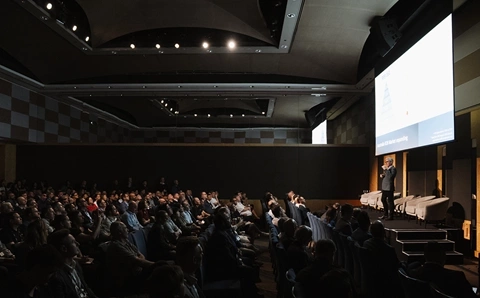Nearly three-quarters of Australian organisations surveyed by Canalys were using business-focussed AI, but more than half didn’t thoroughly review security, governance, risk and compliance implications before deployment, creating a dangerous blind spot.
That was the warning from Mark Iles, Chief Analyst for APAC Channels at Canalys, speaking on September 17 alongside industry leaders at Dicker Data’s Data Resilience in an AI-Driven World summit in Sydney, where vendors and analysts warned the IT channel about emerging data risks – and urged it to rethink what data resilience means in the era of AI.
“Hardly any of the organisations have thoroughly tested whether [AI] increases their cyber risk or could trigger incidents,” Iles said. “It’s a familiar pattern: deploy the technology first, then assess the risks later.
“We’re in the ‘put it in, test it later’ phase. Customers are rushing to deploy AI tools without assessing how it changes their threat profile. That leaves a huge opportunity — and responsibility — for the channel to step in and help.”
Iles showed data indicating that many Australian organisations don’t even have the fundamentals of data recovery in place.
While most executives believe they could recover from a cyberattack in days, the reality is far slower: 80% expect to recover within five days, yet the average is closer to a month.
“That mismatch is a great education opportunity for the channel,” Iles said. “Partners who can bridge that gap — and advise customers on how to build and test resiliency plans effectively will be in a great position to win in the market.”
The same maturity gap shows up in incident response. Around two-thirds of organisations have a plan, but only a third have tested it, and nearly half have experienced an attack in the past 12 months.
“The challenge is that many of these plans are little more than templates and have never been tested,” Iles said. “In many cases, they’re just pieces of paper that no one uses.”
“Just over a quarter of organisations currently have a managed security service, meaning the runway for growth is long. And the logic is simple: cyber has become too complex and too regulated for customers to handle on their own. They will have to lean into partner expertise.”
But the way partners deliver that expertise matters. Iles warned of the danger of remaining “vanilla” as services grow more complex.
“Vanilla won’t be a good place to be in the next two or three years,” he said. “AI is already reshaping how security services are delivered and it’s fast becoming a core component of resilience, and partners who fail to adapt will be left behind.”
Boards want outcomes, not products

Dicker Data’s General Manager of Sales, Cloud & Vendor Alliances, Yasser Elgammal, noted boards’ priorities.
“Australia’s channel faces a pivotal moment, with boards pushing data resilience up the agenda even as budgets tighten, and partners are now expected to build smarter, more resilient systems fit for the AI era,” Elgammal said.
He said the “set and forget” backup mindset is over as ransomware and AI-enabled breaches become more sophisticated.
Elgammal noted that regulatory pressure is pushing these issues higher on organisations’ priority lists, while businesses increasingly see data as a core asset, one that’s spread across hybrid environments and targeted by relentless cyberattacks.
“Boards want continuity, hybrid readiness and compliance, and they want partners who can deliver that as an outcome,” he said.
Spending forecasts show a huge opportunity for channel partners, but seizing it requires them to change how they engage.
“We have to move beyond selling products and security solutions to being able to recover systems, help adapt to changing threats, and ensure business continuity,” Elgammal said.
“Partners need to become their customers’ resilience — not just their vendor. That means acting as a trusted ally, delivering end-to-end lifecycle solutions from design through to deployment and support, and looking beyond backup to build holistic, intelligent and agile data resilience ecosystems.”
Emerging risks

AI is changing the shape of data risk, but what should partners be preparing for?
Panellists from Dell Technologies, Cisco, Lenovo, Microsoft and Check Point Software warned about emerging risks.
Microsoft ANZ National Security Officer Mark Anderson pointed out the risk of attacks at the hardware level.
“We know that threat actors are targeting firmware," said Microsoft's Mark Anderson.
"They’re targeting the supply chain; how do they get into the supply chain, how do they get into the firmware and embed themselves? Once you're in there, you're below the security stack, and if you can sit there nobody will ever find you.”
He also said data resilience depends on treating AI like any other critical asset.
“When we deploy an AI model into a customer’s environment, we treat it no differently to deploying a database,” Anderson said. “It sits within their tenancy, within their security boundary, and inherits all the same protections. It’s just another type of asset.”
But, he warned, the real risk begins once AI is embedded into applications.
“That’s when you have to ask: what data is this model accessing, and what might it expose? The threat doesn’t come from the model simply existing — it comes from how it’s used.”
Check Point Software sales engineering manager Glenn Cole also spoke about securing AI systems.
“AI has changed data resilience in two key ways. It’s helping organisations improve protection and automate security processes — but what many people overlook is the need to secure the AI systems themselves,” Cole said.
“That’s the piece most aren’t thinking about yet, and it’s where partners can make a real impact in the coming months and years: helping customers build security around their AI systems.
Cisco head of solution architecture, Andrew Riley, pointed to post-quantum cryptography as another risk few partners are addressing.
“Harvest-now, decrypt-later attacks are real,” said Cisco's Andrew Riley.
“Partners should start transitioning customers’ VPN and encryption services and asking: do you have a plan?”
Riley said this “future risk” conversation is becoming a litmus test of trust: partners who raise it early position themselves as strategic advisers; those who don’t risk being seen as reactive.
Meanwhile, Dell Technologies’ data protection specialist, Claire Bellenger, warned that data fragmentation is undermining many AI projects, and partners need to fix that before they can credibly talk about resilience.
“Imagine AI as a high-speed train. It’s sleek, powerful, and capable of transforming business landscapes. But this train doesn’t run on fuel — it runs on data. Clean, fast, connected data, flowing seamlessly through partner stations from the edge to the cloud.
“Now picture this: the train is ready to go, but the tracks are fragmented, rusty, and riddled with dead ends. That’s what happens when organisations rely on siloed, inconsistent, and poorly governed data pipelines.”
But even the cleanest, best-orchestrated data pipelines won’t matter if customers can’t recover when disaster strikes, noted Lenovo enterprise solutions specialist Frank Hutchings.
He said too many organisations are still treating cyber incidents like physical disasters, using plans designed for storms or hardware failures while ransomware attacks accelerate.
“We’re seeing an uptick in ransomware attacks, and many customers simply aren’t prepared for recovery. Recovery times are often far longer than expected, which creates serious risk,” Hutchings said.
“We need to start leveraging AI to detect and respond faster — before attacks can cause significant damage.”
What ‘true data resilience’ looks like

Asked to strip away the marketing and define true data resilience, the panel touched on several principles.
Cole described security and AI as two sides of a coin.
“On one side, there’s AI for security: using AI to help humans navigate increasingly complex environments, detect threats faster, and respond more effectively. On the other side is security for AI: making sure the AI systems themselves are protected from risks like data leakage, poisoning, or misuse. Partners need to master both sides if they want to stay ahead as the threat landscape continues to evolve.”
Riley said data resiliency in the AI era must also start at the hardware layer.
“Devices and platforms can be compromised just like operating systems, so you need security from the ground up,” he said.
He urged partners to ask whether customers plan to train their own models or use existing ones — and how they’ll protect both the models and the data they consume.
Resilience requires end-to-end visibility across hardware, identity and data layers in hybrid environments.
Microsoft‘s Anderson encouraged partners to about security “fully end to end, and it is that combination of hardware plus software.”
Microsoft is adopting the memory-safe Rust language and Pluton chip-based security, originally developed to stop Xbox piracy.
Bellenger said that true resilience goes far beyond backup and recovery — it’s about building trust across the entire infrastructure.
She said that starts with zero trust from edge to core to cloud, where every access is verified, anomalies are flagged in real time, and immutable backups are continuously tested, not just stored.
She said it also requires forensic restore environments, offsite vaults for critical applications, and immutable storage as the foundation.
“This is resilience that anticipates threats, adapts to change, and maintains continuity. In the AI era, data isn’t just valuable; it’s vulnerable. That’s why we’re embedding zero trust principles into everything we do.”
Check Point’s Cole noted that while AI can accelerate detection, it won’t magically fix poor governance, and without strong governance, recovery efforts will fail.
“Some people think AI will magically solve their data governance problems, but it won’t,” said Check Point’s Glenn Cole.
“What it can do, though, is help improve governance if it’s implemented well. A well-governed AI system won’t expose data that isn’t already exposed; it works within the existing context and access controls. Used properly, AI can actually reinforce good governance practices rather than replace them,” he said.
“That’s where a real opportunity lies for partners: if you implement AI well — and monitor it closely — it can help address data governance challenges. Instead of trying to fix governance completely before deploying AI, partners can use AI itself as part of the solution.”
New role for the channel
Elgammal closed by urging partners to stop positioning resilience as a cost centre, and start selling it as a business enabler.
“Lead with outcomes: uptime, recoverability, compliance. Build packaged services around business continuity. Offer managed backup, DRaaS and ransomware recovery. Bundle data protection with zero trust,” he said.
“The opportunity is huge. But only if partners make the leap from vendors to trusted allies.”
Elgammal’s recommendations also included:
- Shift from resale to solution selling: Move beyond transactional sales and position as trusted advisors delivering business outcomes.
- Packaging their IP: Build bundled services around unique IP and continuity expertise.
- Use managed services and DRaaS: Drive recurring revenue and help customers overcome budget constraints.
- Architect for hybrid: Design cloud-agnostic, scalable solutions that can evolve with customer needs.
- Integrate cyber and resilience: Treat security and resilience as one — bundle data protection with zero trust for an end-to-end approach.
“The opportunity for the channel is tremendous,” Elgammal said. “Data resilience has become a board-level priority. If partners can step up as trusted advisors, not just vendors, they’ll be indispensable.”
To learn more about becoming a true data resilience partner, contact your Dicker Data representative or email sales@dickerdata.com.au.




_(21).jpg&h=142&w=230&c=1&s=1)







.jpg&w=100&c=1&s=0)
_(8).jpg&w=100&c=1&s=0)










